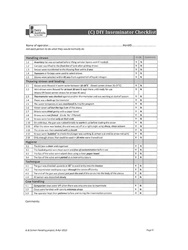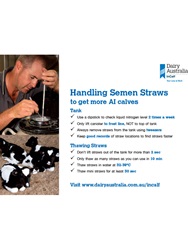Artificial Insemination
Artificial insemination (AI) practices can have a major impact on herd reproductive performance. A low conception rate to AI generally results in lower in-calf rates. Ensuring good AI performance requires the management of five key areas:
- General preparation
- Semen storage and handling
- Insemination technique
- Timing of insemination
- Cow handling
The performance of AI should be measured using the conception rate.
The conception rate can be estimated by dividing the number of pregnancies to AI by the number of semen straws used, or successful inseminations, and multiplying by 100.
AI practices should be reviewed if the conception rates are less than:
- 49% in seasonal or split calving herds
- 43% in year-round herds
- 55% in well-grown heifers
The non-return rate can provide an early warning of a low conception rate to AI and is a worthwhile first check. If the non-return rate for a herd is less than 60% or conception rate is as low as these percentages, further investigation is required.
InCalf research shows that at least 40% of do-it-yourself technicians could achieve at least a 5% increase in conception rates by improving AI practices.
This DIY AI checklist (download below) can help dairy farmers ensure their AI technique is best practice, and watch the video below to understand the effect of poor handling practices on semen mortality.
More information on AI can be found in Section D of the InCalf book 2nd edition pp.95-112 (Genetics, sires, mating strategies and artificial insemination), which you can download at the bottom of the page.
Sexed semen
The sex of the calf is determined by the sperm at fertilisation. Sperm carry either an X (female) or Y (male) chromosome. Technology for sorting an ejaculate into X and Y sperm fractions is under continual development and the industry has access to AI straws containing mostly female (90%+ purity) sperm.
Using sexed semen within an AI program offers potential advantages and some challenges. Dairy farmers are encouraged to obtain up-to-date information on expected conception rate performance and on which animals may be suited to sexed semen before committing to use sexed semen.
For more information on sexed semen see Section D of the InCalf book 2nd edition pp.100-102 (Genetics, sires, mating strategies and artificial insemination), which you can download at the bottom of the page or watch the webinar below.
Handling semen straws poster
Handling semen straws poster
AI training courses
The National Herd Improvement Association (NHIA) offer training courses in artificial insemination. For more information on courses, visit the NHIA website.
Downloads
-
InCalf book for dairy farmers 2nd editions 2017
PDF, 4.14 MB

